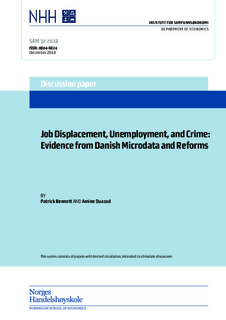| dc.contributor.author | Bennett, Patrick | |
| dc.contributor.author | Ouazad, Amine | |
| dc.date.accessioned | 2019-01-11T11:57:23Z | |
| dc.date.available | 2019-01-11T11:57:23Z | |
| dc.date.issued | 2018-12 | |
| dc.identifier.issn | 0804-6824 | |
| dc.identifier.uri | http://hdl.handle.net/11250/2580333 | |
| dc.description.abstract | This paper estimates the individual impact of a worker’s job loss on his/her criminal activity. Using a matched employer-employee longitudinal data set on unemployment, crime, and taxes for all residents in Denmark, the paper builds each worker’s timeline of job separation, unemployment, and crime. The paper focuses on displaced workers: high-tenure workers who lose employment during a mass-layoff event at any point between 1990 and 1994 (inclusive). Initial local industrial specialization suggests that the growth of manufacturing imports and the Nordic financial crisis in the early 1990s explain a significant share of mass layoffs. Placebo tests display no evidence of trends in crime prior to worker separation. Using Denmark’s introduction of the Act on an Active Labor Market at the end of 1993, we estimate the impacts of activation and of a reduction in benefit duration on crime: crime is lower during active benefits than during passive benefits and spikes at the end of benefit eligibility. We use policy-induced shifts in the kink formula relating prior earnings to unemployment benefits to estimate the separate impacts of labor income and unemployment benefits on crime: the results suggest that unemployment benefits do not significantly offset the impact of labor income losses on crime. | nb_NO |
| dc.language.iso | eng | nb_NO |
| dc.publisher | Institutt for samfunnsøkonomi | nb_NO |
| dc.relation.ispartofseries | DP SAM;32/2018 | |
| dc.title | Job Displacement, Unemployment, and Crime: Evidence from Danish Microdata and Reforms | nb_NO |
| dc.type | Working paper | nb_NO |
| dc.subject.nsi | Samfunnsvitenskap | nb_NO |
| dc.source.pagenumber | 52 | |
